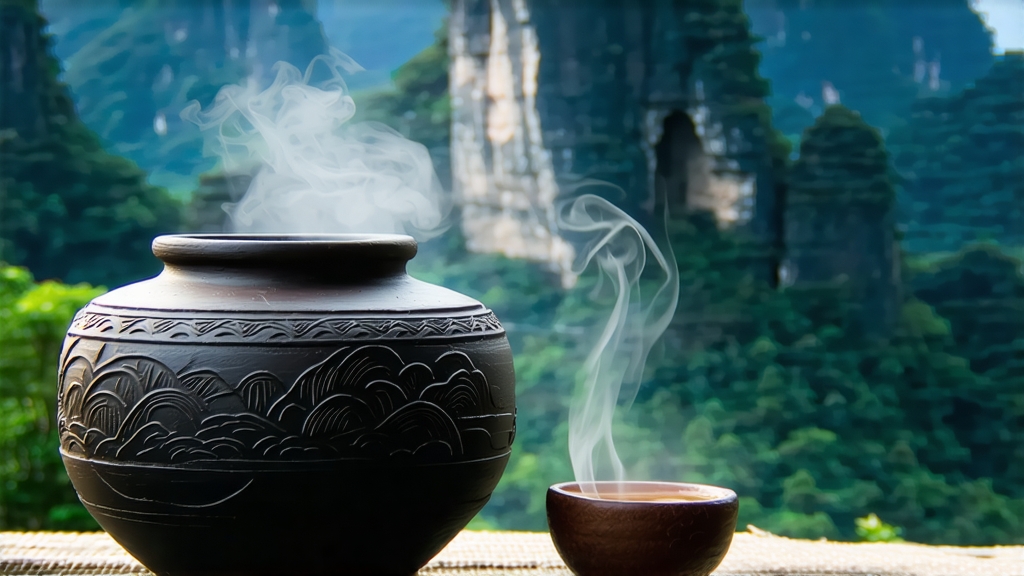
Tucked into the misty folds of southern China’s Guangxi Zhuang Autonomous Region, Liu Bao (literally “Six Forts”) is the quietest celebrity of the dark-tea family. While Pu-erh hoards the limelight, Liu Bao has spent four centuries maturing in bamboo baskets, absorbing the camphor breath of subtropical forests and the mineral whispers of the limestone karst. To the international palate it is still a discovery; to the miners and river men of the Pearl River basin it was once daily currency, a digestif after oily river carp and a safeguard against malaria. Today the tea is riding a second life, prized by sommeliers for its truffle-like umami and by wellness seekers for its blood-lipid lowering prowess.
The origin story begins during the late Ming dynasty, when farmers in the small county of Cangwu packed crude tea into long bamboo tubes for the 2,000-kilometer raft journey down the Liu River to Guangzhou and on to Hong Kong. The humid voyage, measured in weeks, triggered a slow microbial fermentation that softened the leaf and lent it a sweet, earthy depth. By the Qing, the “Six Forts” district—named for six Ming-era garrisons—had become a chartered tea port; imperial records list Liu Bao as one of the 24 tribute teas presented to the Dragon Throne. When the British opened Hong Kong’s first tea auctions in 1842, Liu Bao was catalogued as “Basket Tea, Lingnan Type,” commanding the same price as first-flush Darjeeling.
Unlike Pu-erh’s mountain forests, Liu Bao’s terroir is lowland and karstic. The soil is a reddish calcareous loam shot through with crushed shells—remnants of an ancient seabed—giving the leaf a higher amino-acid count and a natural hint of marine brine. The cultivar is a medium-leaf Camellia sinensis var. sinensis locally called “medium leaf #2,” prized for its thick cuticle that resists the heat and humidity of wet-piling. Farmers pick one bud plus the third and fourth leaves, the so-called “yellow slice” grade, arguing that the older leaves carry more polyphenol oxidase, the enzyme that drives the tea’s unique fermentation.
The craft begins the day after Qingming, when dew-weighted leaves are carried in wicker creels to the village square. There they are wilted for three hours under banana leaves, then wok-fired at 280 °C for eight minutes—just long enough to kill green enzymes while preserving a 12 % moisture core. The twist comes next: instead of rolling, the hot leaves are tossed in bamboo drums lined with burlap. The impact bruises the leaf edges, exposing cell walls to airborne microbes. After 30 minutes the leaf is already bronze at the rim, jade at the vein; this “two-tone” color is the signature that seasoned buyers look for.
What follows is the defining step: wet piling, or wo dui, a controlled composting borrowed from 18th-century horse-caravan tea. The leaf is sprayed with mineral water from the Liu River, heaped 70 cm high, and covered with jute sacks. Every 12 hours the pile is turned and its core temperature measured; the goal is to keep it between 55 °C and 60 °C so that thermophilic Actinobacteria dominate, suppressing harmful molds. After 10–15 days the leaf turns walnut brown and emits a scent reminiscent of porcini and damp camphor. A master can tell readiness by pressing a handful: if the leaf clumps yet springs apart, the “golden flower”—Eurotium cristatum—has bloomed and the pile must be broken up immediately.
Post-fermentation, the tea is sun-dried on bamboo screens for only 40 minutes; Guangxi’s UV index is fierce, and over-drying would lock the leaf into astringency. While still warm it is packed into 50 kg bamboo baskets woven from two-year-old mao zhu. A single basket, called a lang, is lined with wild banana leaf to regulate humidity. The baskets are then stacked in riverside warehouses whose walls sweat with karst groundwater. For the next three years the tea breathes through the bamboo, trading aromas with the camphor beams of the rafters. In traditional tong fang (shared aging rooms) the baskets are rotated every six months so that each side meets the prevailing south wind; this prevents “dead spots” and encourages uniform microbial bloom.